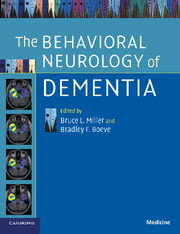Book contents
- Frontmatter
- Contents
- List of contributors
- Section 1 Introduction
- 1 Basic clinical approaches to diagnosis
- 2 Dementia with Lewy bodies
- 3 Neurogenetics of dementia
- 4 Frontotemporal dementia
- 5 Alzheimer's disease
- 6 Mental status examination
- 7 Neuropsychiatric features of dementia
- 8 Neuroimaging in dementia
- 9 Epidemiology and risk factors
- 10 Animal models of dementia
- 11 Neuropathology of dementia
- Section 2 Cognitive impairment, not demented
- Section 3 Slowly progressive dementias
- Section 4 Rapidly progressive dementias
- Index
- References
5 - Alzheimer's disease
Published online by Cambridge University Press: 31 July 2009
- Frontmatter
- Contents
- List of contributors
- Section 1 Introduction
- 1 Basic clinical approaches to diagnosis
- 2 Dementia with Lewy bodies
- 3 Neurogenetics of dementia
- 4 Frontotemporal dementia
- 5 Alzheimer's disease
- 6 Mental status examination
- 7 Neuropsychiatric features of dementia
- 8 Neuroimaging in dementia
- 9 Epidemiology and risk factors
- 10 Animal models of dementia
- 11 Neuropathology of dementia
- Section 2 Cognitive impairment, not demented
- Section 3 Slowly progressive dementias
- Section 4 Rapidly progressive dementias
- Index
- References
Summary
Introduction
While dementia is characterized by a change in cognition that is sufficient to adversely affect a person's daily function in the absence of an acute confusional state or delirium, Alzheimer's disease (AD) more specifically refers to dementia that is slowly progressive with prominent memory dysfunction occurring early in the clinical course. Alois Alzheimer initially described the illness in 1901 with the clinical case of Auguste D., a 51-year-old woman with cognitive disturbance, disorientation, delusions, aphasia and behavioral dyscontrol. A postmortem presentation followed in 1906 and revealed the presenile dementia to be associated with striking generalized cortical atrophy and unique neuropathological changes. In a subsequent 1911 publication, Dr. Alzheimer described in histological detail the now disease-defining neurofibrillary tangles (NFT) and neuritic plaques observed at autopsy, with apparent surprise that the eponymous “Alzheimer's disease” had already been suggested in a textbook by Kraepelin in 1910. Alzheimer's disease now represents the leading cause of dementia worldwide and is a well-known cause of death, disability, and financial burden across cultures.
Epidemiology
In 1990, 4 million people in the USA were estimated to have AD, with an associated projection that this number would escalate to 14 million by 2050. The incidence of AD is age related, doubling every 5 years after the age of 65 years.
- Type
- Chapter
- Information
- The Behavioral Neurology of Dementia , pp. 56 - 73Publisher: Cambridge University PressPrint publication year: 2009
References
- 1
- Cited by



